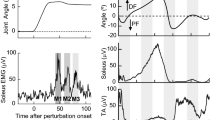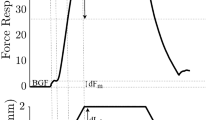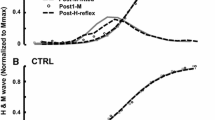Abstract
The purpose of this study was to investigate the effects of hip proprioceptors on soleus stretch reflex excitability in standing humans. A custom-made device to stretch the ankle extensors was mounted on the lower leg portion of a gait orthosis and was used to elicit stretch reflex responses while standing. Six subjects with motor complete spinal cord injury (SCI) and six spinal intact subjects were placed in the orthosis, and stretch reflex responses were elicited when static and/or dynamic hip joint angle changes were imposed. We found that static hip extension significantly enhanced the stretch reflex responses as compared to the neutral position and the hip flexion position only in the SCI group. The EMG magnitude induced by hip extension was 142 ± 16.6% greater than that induced by the neutral position. When the leg was dynamically swung, the reflex responses also changed with the phase of the hip angle in the SCI group; in particular, the reflex amplitude was enhanced with hip extension and in the transition phase from flexion to extension. Although the magnitude of the changes was less than that in the SCI group, a similar type of modulation was found in the normal group. Given the fact that the persons with SCI had lost the neural connection between higher nervous center and the paralyzed lower limb muscles, the mechanism underlying the present results can be attributed to the peripheral afferent input due to the hip angle changes. We concluded that hip mediated afferent input has a significant influence on the excitability modulation of the soleus stretch reflex pathway. Such neural modulation may play a role in the mechanism responsible for the phase-dependent modulation of the stretch reflex while walking.





Similar content being viewed by others
References
Andersson O, Grillner S (1983) Peripheral control of the cat’s step cycle. II. Entrainment of the central pattern generators for locomotion by sinusoidal hip movements during “fictive locomotion”. Acta Physiol Scand 118:229–239
Capaday C, Stein RB (1986) Amplitude modulation of the soleus H-reflex in the human during walking and standing. J Neurosci 6:1308–1313
Chapman CE, Sullivan SJ, Pompura J, Arsenault AB (1991) Changes in hip position modulate soleus H-reflex excitability in man. Electromyogr Clin Neurophysiol 31:131–143
Dietz V, Muller R, Colombo G (2002) Locomotor activity in spinal man: significance of afferent input from joint and load receptors. Brain 125:2626–2634
Ferris DP, Gordon KE, Beres-Jones JA, Harkema SJ (2004) Muscle activation during unilateral stepping occurs in the nonstepping limb of humans with clinically complete spinal cord injury. Spinal Cord 42:14–23
Forssberg H, Grillner S, Halbertsma J (1980) The locomotion of the low spinal cat. I. Coordination within a hindlimb. Acta Physiol Scand 108:269–281
Hultborn H, Meunier S, Pierrot-Deseilligny E, Shindo M (1987) Changes in presynaptic inhibition of Ia fibres at the onset of voluntary contraction in man. J Physiol 389:757–772
Kawashima N, Sekiguchi H, Miyoshi T, Nakazawa K, Akai M (2003) Inhibition of the human soleus H-reflex during standing without descending commands. Neurosci Lett 345:41–45
Kawashima N, Nakazawa K, Yamamoto S-I, Nozaki D, Yano H (2004) Stretch reflex excitability of the anti-gravity ankle extensor muscle in elderly humans. Acta Physiol Scand 180:99–105
Kawashima N, Abe M, Nozaki D, Nakazawa K, Akai M (2005) Alternative leg movement amplifies locomotor-like muscle activity in spinal cord injured persons. J Neurophysiol 93:777–785
Knikou M, Conway BA (2001) Modulation of soleus H-reflex following ipsilateral mechanical loading of the sole of the foot in normal and complete spinal cord injured humans. Neurosci Lett 303:107–110
Knikou M, Rymer Z (2002a) Effects of changes in hip joint angle on H-reflex excitability in humans. Exp Brain Res 143:149–159
Knikou M, Rymer WZ (2002b) Hip angle induced modulation of H reflex amplitude, latency and duration in spinal cord injured humans. Clin Neurophysiol 113:1698–1708
Matthews PB (1986) Observations on the automatic compensation of reflex gain on varying the pre-existing level of motor discharge in man. J Physiol 374: 73–90
Maynard FM Jr, Bracken MB, Creasey G, Ditunno JF Jr, Donovan WH, Ducker TB, Garber SL, Marino RJ, Stover SL, Tator CH, Waters RL, Wilberger JE, Young W (1997) International standards for neurological and functional classification of spinal cord injury. Spinal Cord 35:266–274
Meunier S (1999) Modulation by corticospinal volleys of presynaptic inhibition to Ia afferents in man. J Physiol (Paris) 93:387–394
Nakazawa K, Kawashima N, Akai M, Yano H (2004a) On the reflex co-activation of ankle flexor and extensor muscles induced by a sudden drop of support surface during walking in humans. J Appl Physiol 94:604–611
Nakazawa K, Miyoshi T, Sekiguchi H, Nozaki D, Akai M, Yano H (2004b) Effects of loading and unloading of lower limb joints on the soleus H-reflex in standing humans. Clin Neurophysiol 115:1296–1304
Nozaki D, Nakazawa K, Yamamoto Y (1996) Supraspinal effects on the fractal correlation in human H-reflex. Exp Brain Res 112:112–118
Pearson KG (1995) Proprioceptive regulation of locomotion. Curr Opinion Neurobiol 5:786–791
Sinkjaer T, Andersen JB, Larsen B (1996) Soleus stretch reflex modulation during gait in humans. J Neurophysiol 76:1112–1120
Steldt RE, Schmit BD (2004) Modulation of coordinated muscle activity during imposed sinusoidal hip movements in human spinal cord injury. J Neurophysiol 92:673–685
Yang JF, Whelan PJ (1993) Neural mechanisms that contribute to cyclical modulation of the soleus H-reflex in walking in humans. Exp Brain Res 95:547–556
Acknowledgements
The authors would like to thank H. Otsuka for the preparation of the experimental device. This work was supported by a grant from the Japanese Ministry of Health and Labor and the Japanese Society for Rehabilitation of Persons with Disabilities.
Author information
Authors and Affiliations
Corresponding author
Rights and permissions
About this article
Cite this article
Kawashima, N., Yano, H., Ohta, Y. et al. Stretch reflex modulation during imposed static and dynamic hip movements in standing humans. Exp Brain Res 174, 342–350 (2006). https://doi.org/10.1007/s00221-006-0470-2
Received:
Accepted:
Published:
Issue Date:
DOI: https://doi.org/10.1007/s00221-006-0470-2




